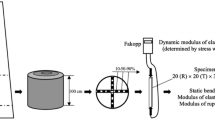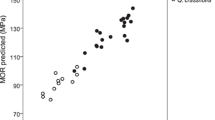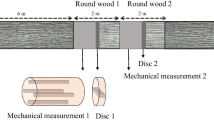Abstract
Small clear specimens of 30×30×450 mm were prepared from plantation-grown Eucalyptus globulus, E. nitens and E. regnans that were between 15 and 31 years of age. Their modulus of elasticity (MOE) and modulus of rupture (MOR) were determined using static central-point-loading bending tests. Their microfibril angle (MFA) and density were determined using SilviScan on strip samples removed from the intact portion of the specimens after the bending tests. It was found that MFA alone accounted for 87 percent of the variation in MOE, while density alone accounted for 81 percent. Together, MFA and density (as Density/MFA) accounted for 92 percent of the variation in MOE. The MFA “impact diminishing” pointFootnote 1 appears to be 16 degrees for the wood material of three eucalypt species in this study. Density alone accounted for 80 percent of the variation in MOR, whereas MFA had little independent influence on MOR.
Zusammenfassung
Kleine fehlerfreie Proben (30×30×450 mm) wurden aus 15 bis 33 Jahre alten Eucalyptus globulus, E. nitens und E. regnans aus Plantagenanbau geschnitten. Deren MOE und MOR wurden unter statischer zentraler Belastung im Biegetest bestimmt. Außerdem wurden der Mikrofibrillenwinkel (MFA) und die Dichte bestimmt, und zwar mittels SilviScan an Probestreifen, die nach dem Biegetest aus intakten Probeteilen geschnitten wurden. Es zeigte sich, daß allein der Mikrofibrillenwinkel zu 87 Prozent für die Variation des MOE verantwortlich ist, die Dichte für sich allein nur für 81 Prozent. MFA und Dichte zusammen (als Quotient Dichte/MFA) erklären 92 Prozent der Variation des MOE. Die Grenze des negativen Einflusses des Mikrofibrillenwinkels scheint für das vorliegende Probenmaterial bei 16 Grad zu liegen. Im Falle des MOR ist die Dichte allein für 80 Prozent der Variation verantwortlich, wogegen der MFA nur einen geringen unabhängigen Einfluß auf den MOR hat.



Similar content being viewed by others
Notes
A MFA value beyond which an increase in MFA results in little further decrease in MOE.
Other forms of equations, e.g. polynomial and log relationships, could also well predict measured MOE as found in this study.
References
Cave ID, Walker JCF (1994) Stiffness of wood in fast-grown plantation softwoods: The influence of microfibril angle. For Prod J 44(5):43–48
Dickson RL, Walker JCF (1997) Selecting wood quality characteristics for pines. In: Proceedings of CTIA/IUFRO International Wood Quality Workshop “Timber Management Toward Wood Quality and End-Product Value”, Quebec City, Canada, 18–22 August 1997
Evans R, Ilic J (2001) Rapid prediction of wood stiffness from microfibril angle and density. For Prod J 51(3):53–57
Evans R, Ilic J, Matheson AC (2000) Rapid estimation of solid wood stiffness using SilivScan. In: Proceedings of 26th For. Prod. Res. Conf., CSIRO Forestry and Forest Products, Clayton, Australia, pp 49–50
Hirakawa Y, Yamashita K, Fujisawa Y, Nakada R, Kijidani Y (1997) The effects of S2 microfibril angles and density on MOE in sugi tree logs. Proceedings (ed. Butterfield, B.G.) IAWA/IUFRO International Workshop on the Significance of Microfibril Angle to Wood Quality, Westport, New Zealand, November 1997, pp 312–322
Kollmann FFP, Côté WA Jr. (1984) Principles of wood science and technology. I. Solid wood. Springer, Berlin Heidelberg New York p 292
Mack JJ (1979) Australian methods for mechanically testing small clear specimens of timber. CSIRO Div. Build. Res. Technical Paper (2nd series) No. 31, 19 pp
Panshin AJ, de Zeeuw C (1980) Textbook of wood technology. McGraw-Hill Book Company, New York, 722 pp
Tsehaye A, Buchanan AH, Walker JCF (1995) A comparison of density and stiffness for predicting wood quality or density: the lazy man’s guide to wood quality. J Instit Wood Sci 13(6):539–543
Walker JCH, Butterfield BG (1995) The importance of microfibril angle for the processing industries. New Zealand Forestry, November 1995
Yang JL, Wardlaw T, Scott L (2000) Density and strength characteristics of discolored and decayed regrowth eucalypts—a preliminary study. Australian Forestry 63(3):188–193
Yang JL, Waugh G (1996a) Potential of plantation-grown eucalypts for structural sawn products. I. Eucalyptus globulus Labill. spp. globulus. Australian Forestry 59:90–98
Yang JL, Waugh G (1996b) Potential of plantation-grown eucalypts for structural sawn products. II. Eucalyptus nitens (Deane & Maiden) Maiden and E. regnans F. Muell. Australian Forestry 59:99–107
Acknowledgement
We thank Mrs S Molenaar for the static bending tests, Mr. J Ilic and Mr. G Freischmidt of CSIRO for their valuable comments on this manuscript prior to submission to the journal.
Author information
Authors and Affiliations
Corresponding author
Rights and permissions
About this article
Cite this article
Yang, J.L., Evans, R. Prediction of MOE of eucalypt wood from microfibril angle and density. Holz Roh Werkst 61, 449–452 (2003). https://doi.org/10.1007/s00107-003-0424-3
Published:
Issue Date:
DOI: https://doi.org/10.1007/s00107-003-0424-3




